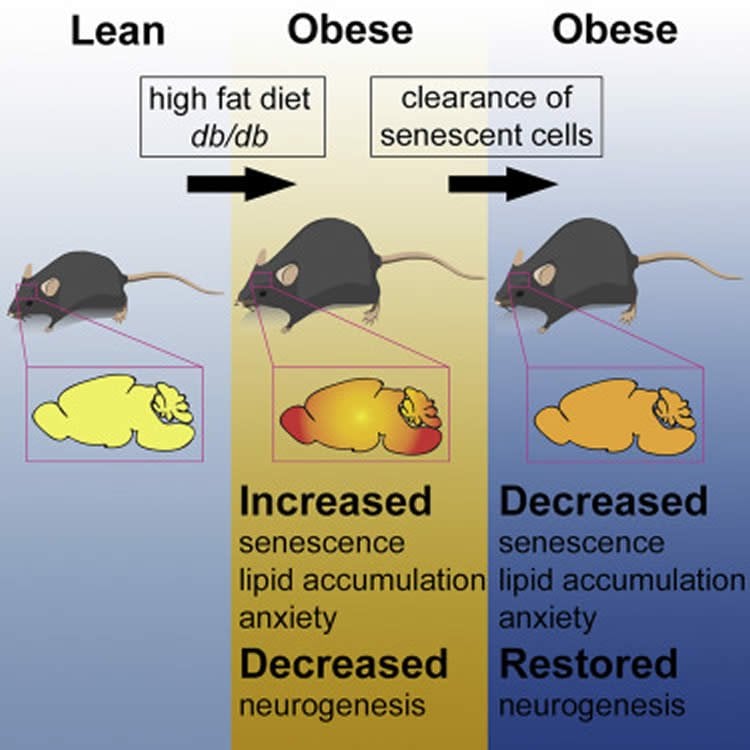Summary: According to researchers, obese mice have increased levels of senescent cells in their brains, and these cells contribute to anxiety. Using senolytics to clear the cells helps to reduce anxiety related behaviors.
Source: Mayo Clinic.
Mayo Clinic researchers and collaborators have shown in mice that obesity increases the level of “zombie” or senescent cells in the brain, and that those cells, in turn, are linked to anxiety. When senolytic drugs are used to clear those cells, the anxious behaviors in the mice dissipate. These findings appear in Cell Metabolism.
Senscent cells are just as the name zombie implies – semidormant cells that remain in a given area of the body and, by doing so, impair other functions. Research has shown that they contribute to aspects of aging, from osteoporosis to diabetes and muscle weakness. In this case, researchers knew that obesity — in both humans and mice — is related to increased anxiety and other emotional issues. Yet the details of that relationship are unclear.
Using genetically modified mice and normal mice, the team, which included researchers from the Mayo Clinic Robert and Arlene Kogod Center on Aging and the University of Newcastle, as well as others, determined that the study mice developed more fat cells in the brain area that controls anxiety and they had a significant increase of senescent cells in that region. Clearing the cells with senolytic drugs in the two mouse models resulted in anxious behavior ending; lipid cells in the brain disappearing; and neurogenesis, or normal neurological cell growth, resuming.

How do you tell if a mouse has anxiety? A number of scientifically validated tests are used. An anxious mouse tends to avoid open areas in its environment, and tends to move only along the outside walls or corners of its enclosure. Also, anxious mice behave differently in mazes, performing poorly and with hesitation, often not completing the test. After removal of the zombie cells, the mice did much better even though they were still obese.
In their paper the authors say, “Our data demonstrating a link between obesity, senescence and anxietylike behavior provide critical support for the potential feasibility of administering senolytics to treat obesity-associated anxietylike behavior, provided that clinical trials validate this approach.”
They say more preclinical research is needed, as well, to determine which type of senescent cells are responsible and define the mechanism of action more fully.
Funding: Support for the research came from Cancer Research UK, a Newcastle University Faculty of Medical Sciences Fellowship, The Academy of Medical Sciences, The Connor Group, the National Institutes of Health, the Glenn/American Federation for Aging Research Breakthroughs in Gerontology award, Robert and Theresa Ryan, The Ted Nash Long Life and Noaber Foundations, Regenerative Medicine Minnesota, and Humor the Tumor.
Researchers include first author Mikolaj Ogrodnik, Ph.D., and senior authors Diana Jurk, Ph.D., formerly of University of Newcastle and now at Mayo Clinic, and James Kirkland, M.D., Ph.D., of Mayo Clinic. The team also included researchers from Stony Brook University, Moscow Institute of Physics and Technology, University of Texas Health Sciences Center, and the Near East University, Cyprus.
Source: Bob Nellis – Mayo Clinic
Publisher: Organized by NeuroscienceNews.com.
Image Source: NeuroscienceNews.com image is credited to Ogrodnik et al./Cell Metabolism.
Original Research: Open access research for “Obesity-Induced Cellular Senescence Drives Anxiety and Impairs Neurogenesiss” by Mikolaj Ogrodnik, Yi Zhu, Larissa G.P. Langhi, Tamar Tchkonia, Patrick Krüger, Edward Fielder, Stella Victorelli, Rifqha A. Ruswhandi, Nino Giorgadze, Tamar Pirtskhalava, Oleg Podgorni, Grigori Enikolopov, Kurt O. Johnson, Ming Xu, Christine Inman, Marissa Schafer, Moritz Weigl, Yuji Ikeno, Terry C. Burns, João F. Passos, Thomas von Zglinicki, James L. Kirkland, and Diana Jurk in Cell Metabolism. Published January 3 2019.
doi:10.1016/j.cmet.2018.12.008
[cbtabs][cbtab title=”MLA”]Mayo Clinic”Obese Mice Lose Anxiety When ‘Zombie Cells’ Exit the Brain.” NeuroscienceNews. NeuroscienceNews, 3 January 2019.
<https://neurosciencenews.com/anxiety-obese-zombie-cells-10418/>.[/cbtab][cbtab title=”APA”]Mayo Clinic(2019, January 3). Obese Mice Lose Anxiety When ‘Zombie Cells’ Exit the Brain. NeuroscienceNews. Retrieved January 3, 2019 from https://neurosciencenews.com/anxiety-obese-zombie-cells-10418/[/cbtab][cbtab title=”Chicago”]Mayo Clinic”Obese Mice Lose Anxiety When ‘Zombie Cells’ Exit the Brain.” https://neurosciencenews.com/anxiety-obese-zombie-cells-10418/ (accessed January 3, 2019).[/cbtab][/cbtabs]
Abstract
Obesity-Induced Cellular Senescence Drives Anxiety and Impairs Neurogenesis
Cellular senescence entails a stable cell-cycle arrest and a pro-inflammatory secretory phenotype, which contributes to aging and age-related diseases. Obesity is associated with increased senescent cell burden and neuropsychiatric disorders, including anxiety and depression. To investigate the role of senescence in obesity-related neuropsychiatric dysfunction, we used the INK-ATTAC mouse model, from which p16Ink4a-expressing senescent cells can be eliminated, and senolytic drugs dasatinib and quercetin. We found that obesity results in the accumulation of senescent glial cells in proximity to the lateral ventricle, a region in which adult neurogenesis occurs. Furthermore, senescent glial cells exhibit excessive fat deposits, a phenotype we termed “accumulation of lipids in senescence.” Clearing senescent cells from high fat-fed or leptin receptor-deficient obese mice restored neurogenesis and alleviated anxiety-related behavior. Our study provides proof-of-concept evidence that senescent cells are major contributors to obesity-induced anxiety and that senolytics are a potential new therapeutic avenue for treating neuropsychiatric disorders.






